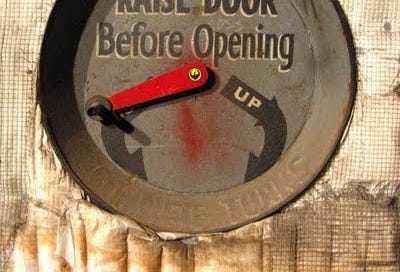The Elephant Door
Big enough for, well, you know...
One of the more distinctive aspects of a real sound stage* is the elephant door — so-called, I presume, because such doors are large enough to allow the entry of an adult pachyderm. I'm not sure there's any particular dimensional standard for such doors, but although seldom called upon to admit real live elephants these days, they need to be tall enough to allow 14 foot set walls to pass through.**
These doors are massive — six to eight inches thick (for soundproofing) and extremely heavy. Nowadays, most use electric motors to slowly open and close, but at the studio where I first started, many of those doors were operated manually: shoved open or shut by the strong backs of the crew. Gravity provided the locking mechanism, with a wheel or chains employed to engage a mechanism to raise or lower the door as required. The strangest elephant door I ever saw was at the back of Stage 32 at Paramount (the "haunted" stage where some of the original Star Trek television show was filmed), which opened and closed using water power. How this actually worked remains the deepest of mysteries to me, but something went wrong halfway through that show, so the door stayed shut from then on.
Electric and gravity doors have strengths and weaknesses. When an electric door has a problem (which happens more often than you'd think), the door usually ends up stuck open, bringing production to a screeching halt. This does not please the producers, which means the studio has to kick into high gear to get the damned thing fixed ASAP. Although gravity doors don't have that problem, they're not immune to the perils of Newtonian Physics. Early in my career, I slammed a gravity door shut with enough momentum to bounce it off the track — and for a briefly horrifying moment, I thought the whole thing was about to topple inward, crushing me and several other hapless innocents whom fate had brought to the fatal crossroads of The Wrong Place and The Wrong Time. Fortunately, this stab of raw panic proved groundless: that big door was solidly frozen in place and going nowhere.
My problems weren't over, though. Still trying to earn my spurs and build a reputation as a reliable griptrician in Hollywood, I'd instead demonstrated very poor judgment that impeding the production, so I was greatly relieved when the stage manager arrived with a forklift a few minutes later to lift the big door back on its track, thus taking me off the hook.
Another bullet dodged.
During winter, the elephant door keeps the cold and rain on the outside and the heat on the inside. In the fierce San Fernando Vally summers, massive air conditioning units maintain comfortable working conditions on stage while crews shooting day exteriors broil in 100+ degree temperatures. When walking or riding a bicycle down the alleys between stages in that suffocating summer heat, a deliciously cool wave of refrigerated air flows out from the occasional open elephant door — one of those slow-motion sense memories I'll take with me to my grave.
Without those big stage doors, those of us who do the heavy lifting in Hollywood would be a lot more miserable.
The elephant door defines a sound stage, sealing it off from the outside world and setting the tone for what goes on inside. When wide open, filming stops. Lots of other things can be going on — rigging, wrapping, building/tearing down sets, or simply a break in the action — but actors aren’t performing for the cameras when that big door is open.*** Everything is more relaxed, as crew members grab a quick smoke, make a phone call, or simply stare up at the blue sky and the great outdoors … but eventually that big door slowly glides shut and the outside world of sunshine and sky vanishes as we return to a world of darkness, artificial light, and make-believe.
Then it's time to get back to work, and the business of Hollywood.
* As opposed to one of the many insert stages found in industrial areas all over the LA Basin, which typically consist of a thin, decidedly non-soundproof shell equipped with a pipe grid hung from the rafters. Insert stages have their uses, but I'll take a real sound stage every time.
** Just once, during my brief career as an LD (Lighting Director — basically a glorified gaffer making a much fatter daily rate) did I see an elephant walk through one of those big doors. Three elephants, actually, two adults and a baby, on Stage 5 at Raleigh Hollywood, where they starred in a commercial for the California Lottery. It was an impressive sight ... and shades of D.W. Griffith's Hollywood.
*** There are exceptions to every rule. The crew of Samantha Who? built some of their sets right out the open elephant door and into the alley. That was one very expensive half-hour comedy, which led to its demise. As I heard it, the network demanded a cut in production costs of $500,000 per week to fund a third season, and when the producers balked, the axe came down.





